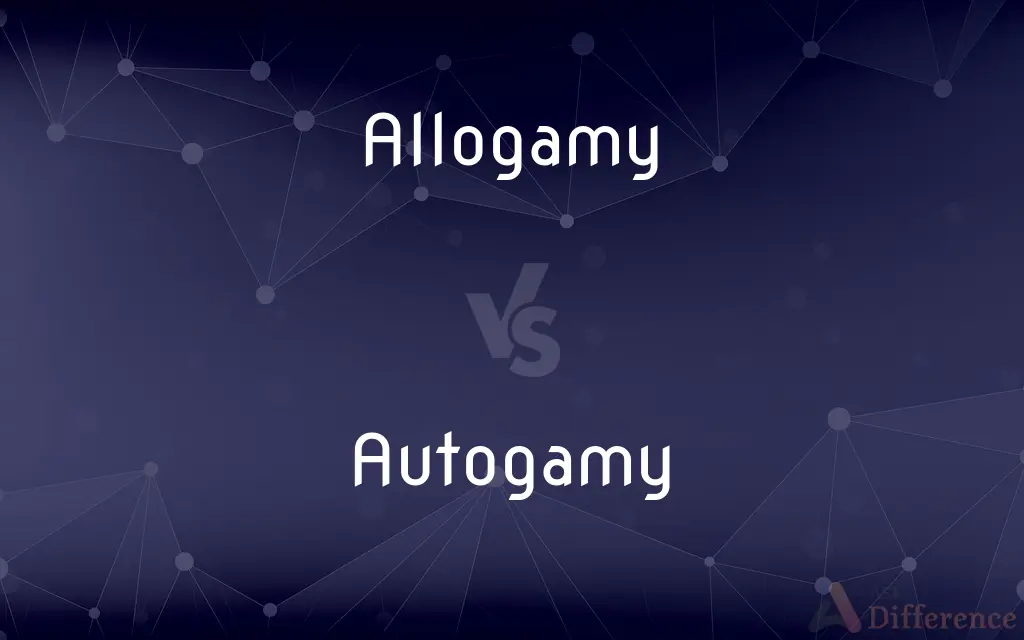Allogamy vs. Autogamy — What's the Difference?
By Tayyaba Rehman — Updated on September 27, 2023
Allogamy is the fertilization of an ovule by pollen from a different plant, promoting genetic diversity. Autogamy is the process where a flower fertilizes itself, typically leading to less genetic variation.

Difference Between Allogamy and Autogamy
Table of Contents
ADVERTISEMENT
Key Differences
Allogamy and Autogamy represent contrasting reproductive strategies in the plant kingdom, significantly impacting genetic diversity and evolutionary adaptability. Allogamy involves the fusion of gametes from different individuals, facilitating genetic diversity and adaptability. It occurs through cross-pollination, involving different plants of the same species. This variability allows for healthier and more resilient populations, enabling them to adapt to changing environmental conditions.
Autogamy, on the other hand, involves self-fertilization, where a single plant contributes both types of gametes, leading to progeny that are genetically identical to the parent. This process can ensure reproductive success in isolated or stable environments, where introducing new genetic material might be disadvantageous. Autogamy can be advantageous in stable, unchanging environments, as it maintains well-adapted genotypes and requires fewer resources related to pollination mechanisms.
In terms of ecological and evolutionary implications, allogamy promotes genetic diversity, ecological adaptability, and evolution of the species. The genetic diversity resulting from allogamy can lead to enhanced resistance to diseases and pests and better adaptation to environmental changes, safeguarding the continuity of the species.
Conversely, autogamy can be more prevalent in harsh or isolated environments where finding a mate is challenging. It assures reproduction but leads to inbreeding, which may cause the accumulation of deleterious mutations and a reduction in genetic diversity, making the species more vulnerable to environmental changes and diseases.
In conclusion, while allogamy provides genetic diversity and adaptability, allowing species to thrive in varying environments, autogamy guarantees reproduction success in stable or isolated conditions but may limit genetic diversity and adaptability.
ADVERTISEMENT
Comparison Chart
Definition
Fertilization involving gametes from different plants.
Self-fertilization within the same plant.
Diversity
Promotes genetic diversity.
Leads to less genetic diversity.
Occurrence
Occurs through cross-pollination.
Occurs through self-pollination.
Adaptation
Enhances adaptability and evolutionary progress.
Limits adaptability and evolutionary progress.
Environment
Favorable in diverse environments.
Prevalent in isolated or stable environments.
Compare with Definitions
Allogamy
A form of sexual reproduction combining genes from different individuals.
Allogamy ensures that plants have diverse genetic makeups, promoting adaptability and resilience.
Autogamy
A mechanism ensuring reproduction when cross-pollination is not feasible.
Autogamy is a fallback reproductive strategy for plants in areas with scarce pollinators.
Allogamy
It requires agents like wind, water, or animals for pollination.
The reliance on bees and other insects makes allogamy a crucial ecological process.
Autogamy
It usually leads to the production of genetically identical offspring.
The uniformity of the plant population was due to the prevalence of autogamy.
Allogamy
It tends to occur in plants having unisexual flowers.
The presence of unisexual flowers on separate plants encourages allogamy, increasing genetic diversity.
Autogamy
The process where a single plant’s flower fertilizes itself.
Some plant species have adapted to perform autogamy to ensure reproductive success in isolated environments.
Allogamy
It often results in offspring with varied genetic combinations.
The biodiversity in the forest is primarily due to allogamy among the various plant species.
Autogamy
It can lead to inbreeding and accumulation of deleterious mutations.
Relying solely on autogamy can lead to a decrease in a population’s overall fitness due to inbreeding depression.
Allogamy
The fusion of an egg and a sperm from different individuals of the same species.
The flowering plants in the field exhibited allogamy through the action of pollinators.
Autogamy
Autogamy, or self-fertilization, refers to the fusion of two gametes that come from one individual. Autogamy is predominantly observed in the form of self-pollination, a reproductive mechanism employed by many flowering plants.
Allogamy
Allogamy or cross-fertilization is the fertilization of an ovum from one individual with the spermatozoa of another. By contrast, autogamy is the term used for self-fertilization.
Autogamy
Fertilization of a flower by its own pollen.
Allogamy
See cross-fertilization.
Autogamy
The union of nuclei within and arising from a single cell, as in certain protozoans and fungi.
Allogamy
See cross-pollination.
Autogamy
Self-fertilization, the fertilizing pollen being derived from the same blossom as the pistil acted upon.
Allogamy
(biology) The fertilization of an ovum from one individual with the spermatozoa of another; cross-fertilization
Autogamy
Sologamy, marriage to oneself.
Allogamy
Fertilization of the pistil of a plant by pollen from another of the same species; cross-fertilization.
Autogamy
Self-fertilization, the fertilizing pollen being derived from the same blossom as the pistil acted upon.
Allogamy
Cross-fertilization in plants
Autogamy
Self-fertilization in plants
Autogamy
This method does not require external pollinating agents.
Autogamy occurs without the need for wind, water, or animals, making it an efficient reproductive method in stable environments.
Common Curiosities
Can allogamy lead to healthier populations?
Absolutely, the genetic diversity from allogamy can result in healthier and more adaptable populations.
Does allogamy require external agents for pollination?
Yes, allogamy usually requires agents like wind, water, or animals for pollination.
Is autogamy more common in isolated environments?
Yes, autogamy is more prevalent in isolated or harsh environments where finding a mate is challenging.
Is autogamy a form of self-fertilization?
Yes, autogamy is indeed a form of self-fertilization.
Does allogamy promote genetic diversity?
Yes, allogamy significantly promotes genetic diversity within a species.
Is allogamy advantageous in changing environments?
Indeed, allogamy is advantageous in changing environments due to enhanced adaptability.
Can autogamy lead to inbreeding?
Yes, autogamy can result in inbreeding and accumulation of deleterious mutations.
Does autogamy conserve energy and resources related to pollination mechanisms?
Yes, autogamy typically requires fewer resources and energy related to pollination mechanisms.
Share Your Discovery

Previous Comparison
Creaky vs. Rickety
Next Comparison
Hayfork vs. PitchforkAuthor Spotlight
Written by
Tayyaba RehmanTayyaba Rehman is a distinguished writer, currently serving as a primary contributor to askdifference.com. As a researcher in semantics and etymology, Tayyaba's passion for the complexity of languages and their distinctions has found a perfect home on the platform. Tayyaba delves into the intricacies of language, distinguishing between commonly confused words and phrases, thereby providing clarity for readers worldwide.
















































